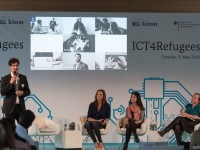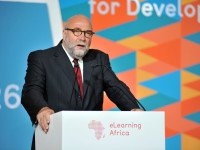 It was not a coincidence that this year’s eLearning Africa was held under the patronage of the German Federal Minister for Economic Cooperation and Development, Dr. Gerd Müller. 2016 is the year of digital education in Germany! This year, the German Government has declared digital education a priority of its national Digital Agenda. German Development Cooperation has also recognized the high potential of ICT particularly for improving access to quality education for refugees. Therefore, the Deutsche Gesellschaft für Internationale Zusammenarbeit (GIZ) organized on behalf of the Federal Ministry for Economic Cooperation and Development (BMZ) a session on ICT for Refugee Education at eLearning Africa. The aim of the session was to generate stronger dialogue and engage experts and practitioners in peer-to-peer learning and greater collaboration in the evolving field of ICT for refugee education. In an interactive gallery walk Borderless Higher Education for Refugees (BHER), One Mobile Projector per Trainer (OMPT), Xavier Project and FHI 360 presented their projects, which reflected the wide range of ICT solutions for refugee education: blended-learning in higher education, video education for life skills, SMS-based learning tools or apps for tablet-based monitoring in humanitarian crisis contexts. Participants discussed program implementation challenges, Do No Harm approaches, sustainability and scale as well as monitoring and evaluation.
It was not a coincidence that this year’s eLearning Africa was held under the patronage of the German Federal Minister for Economic Cooperation and Development, Dr. Gerd Müller. 2016 is the year of digital education in Germany! This year, the German Government has declared digital education a priority of its national Digital Agenda. German Development Cooperation has also recognized the high potential of ICT particularly for improving access to quality education for refugees. Therefore, the Deutsche Gesellschaft für Internationale Zusammenarbeit (GIZ) organized on behalf of the Federal Ministry for Economic Cooperation and Development (BMZ) a session on ICT for Refugee Education at eLearning Africa. The aim of the session was to generate stronger dialogue and engage experts and practitioners in peer-to-peer learning and greater collaboration in the evolving field of ICT for refugee education. In an interactive gallery walk Borderless Higher Education for Refugees (BHER), One Mobile Projector per Trainer (OMPT), Xavier Project and FHI 360 presented their projects, which reflected the wide range of ICT solutions for refugee education: blended-learning in higher education, video education for life skills, SMS-based learning tools or apps for tablet-based monitoring in humanitarian crisis contexts. Participants discussed program implementation challenges, Do No Harm approaches, sustainability and scale as well as monitoring and evaluation.
The session complements a series of activities that German Development Cooperation is conducting to move the field of ICT for refugee education forward. In March, GIZ has launched the study “Education in Conflict and Crisis: How Can Technology Make a Difference? A Landscape Review” at the UNESCO Mobile Learning Week. The study was commissioned by GIZ in the framework of the Mobiles for Education Alliance in collaboration with All Children Reading: A Grand Challenge for Development (USAID, World Vision, Australian Aid), World Vision International, the Inter-agency Network on Education in Emergencies (INEE) and Creative Associates International. It aims at identifying promising practices in the field, but also knowledge gaps and provides recommendations:
- Focus on Efficient Technology Usage, Local Maintenance, and Local Procurement: Ensure a plan for local, long-term maintenance, and procure appropriate and locally available technology.
- Have Clarity in The Purpose and Context of ICT Use: Assess local conditions and define clearly the purpose of intervention before implementation; work with community members to determine appropriate ICT application.
- Consider “System Strengthening” Initiatives: Analyze and compile best practice related to system strengthening in crisis and conflict in order to bring ICT to its full potential with regard to system strengthening.
- Attend to the Needs of Inclusive Education: Focus more on inclusion of additionally vulnerable populations such as girls and people with disabilities.
- Consider Do No Harm and Conflict-Sensitive Education: Consider privacy, security, and digital data ownership. Attention should also be paid to the needs and interests of host communities. Develop an ICT supplement for existing conflict analysis tools to help evaluate the appropriateness of ICT supported education interventions in crisis and conflict settings.
- Identify Accreditation and Certification Mechanisms: Find ways to accredit or certify learning and consider digital tools and platforms to support these processes. Provide accredited or certified opportunities for non-formal learning that can transition into formal education.
- Acknowledge the “Claims vs. Evidence” Gap and Compile Resources: Improve documentation and access to information about projects, research, evaluation, and related theory.
- Create Cross-Sectoral Collaboration: Explore possible benefits from collaboration and partnership focused on cross-sectoral, locally situated problems related to education.
- Explore Informal Learning Structures: Use digital media and social networks as vehicles for information on access to education and support for educational initiatives.
The study was also discussed in a webinar organized by GIZ on behalf of BMZ together with INEE and UNHCR. Dr. Negin Dahya, University of Washington, the author of the above mentioned study, Laura Stankiewicz, the author of another study focusing specifically on “Technology for Refugee and IDP Education”, Mary Mendenhall, Columbia University, and Peter Mading Angong, a primary school teacher in the Kakuma Refugee Camp, discussed the question “Education and forced displacement – How can technology make a difference?”.
ICT4Refugees was also the topic of a conference organized on May 31 in Berlin by BMZ in cooperation with the betterplace lab and Kiron Open Higher Education, bringing together stakeholders from government, the technology community, and grassroots initiatives to share practical solutions, approaches, and future ideas on the use of ICT to support refugees. Alongside other topics, an evaluation of the technology needs and challenges from field research in Greece, Jordan and Turkey was presented.
 As Günter Nooke, Personal Representative of the German Chancellor for Africa and Commissioner for Africa of BMZ, said during his key note in the eLearning Africa Opening Plenary: “Refugee Education is one of the most pressing issues that we have to address internationally.”
As Günter Nooke, Personal Representative of the German Chancellor for Africa and Commissioner for Africa of BMZ, said during his key note in the eLearning Africa Opening Plenary: “Refugee Education is one of the most pressing issues that we have to address internationally.”



















Great initiative!